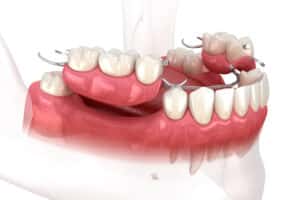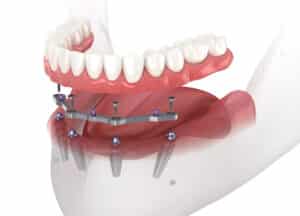As many of you are aware, Nobel Biocare has presented a technique for Dental Implants which they call Teeth in an Hour. This technique has been heavily marketed and involves the production of a computer-generated surgical guide which may then be used to direct the placement of implants into either an edentulous mandible or maxilla. Following the placement of dental implants and the placement of abutments, a prefabricated final bridge is immediately placed.
The technique, which combines computerized surgical and prosthetic treatment planning coupled with flapless surgery and the immediate placement of a final prosthesis in one sitting, seems on the surface to be a major step forward in implant dentistry. Some of its advantages include a one-stage flapless procedure, limited bleeding and post-operative pain, and the potential to treat fragile patients. However, there has been limited data to support this innovative approach. Preliminary data demonstrated success rates in the 95% range.
Recently at the Fifth World Congress of Osseointegration, which was held in Venice, Italy on February 15-17, 2007, Professor Bjorn Klinge presented a study on Nobel Biocares Teeth in an Hour concept. The presentation was titled Success and Failure Following Computer-Assisted Virtual Treatment Planning in Immediate Loading of Edentulous Patients. It should be noted that Professor Klinge of the Karolinska Institute is one of three independent MPA panelists for the NobelDirect implant investigation in Sweden. Professor Klinges single-centre data showed a 29% complication rate with up to three years follow-up. His data were based on the treatment of 31 arches and 175 dental implants. Professor Klinge went on to say that the 71% success rate remains an over estimate of true success since the current data are only clinical in nature and do not include radiographic data. Therefore, the true success rate is expected to be less than 71%. Dr. Klinge states that this technique remains in the exploratory phase.
I applaud Nobel Biocares visionary approach. However, considering that the gold standard for implant success remains in the 95% range, I personally have a difficult time adding this technique (71% success) to my implant protocol. It is my opinion that accelerated computer-guided implant protocols seem to be of clinical value. However, the practitioner must always perform a risk-benefit analysis prior to performing treatment. It appears to me that increasing failure rates by about 500% in an effort to accelerate treatment is not something with which I am comfortable.
In our practice we continue to offer immediate implant placement and immediate fixed provisionalization using an approach supported by published clinical data. In one such paper published in COIR, Dr. Testori and I demonstrated a 99.38% implant success rate over a five-year period with immediate placement and restoration. While we continue to research combining computer-guided implant surgery and restoration, it remains part of a research protocol within our practice and should not be viewed as the standard of care until sufficient data are available.
Let us never lose sight as we move forward that there are people attached to these dental implants.
Note: NobelGuide, Teeth in an Hour and NobelDirect are trademarked by Nobel Biocare.





